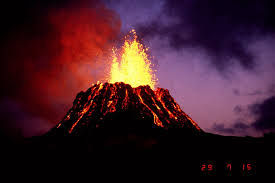Kīlauea Erupts Again
- Alexa Levitt

- Jan 24
- 2 min read
Of six active volcanoes in the state of Hawaii, Kīlauea is the youngest and most active volcano currently. On December 23rd, 2024, Kīlauea began erupting. Located on the Big Island of Hawaii, this volcano erupted three times in 2024 alone. This eruption, unlike previous eruptions in recent years, occurred in three places simultaneously. This hasn't happened in 50 years. Lava reached heights of nearly 300 feet, covering almost 650 acres.
Kīlauea is made up of one large summit caldera, a depression in which most eruptions take place, called Kaluapele. In the southwest region of the caldera is a smaller crater called Halema’uma’u.The volcano also has two rift zones, the East Rift Zone and the Southwest Rift Zone. A rift zone is an area of weakness near the volcano under which magma travels. These rift zones are prone to volcanic activity. This eruption occurred in all three locations, Halema’uma’u, the East Rift Zone, and the Southwest Rift Zone. The main eruption occurred in the southwest of the Halema’uma’u crater.

This eruption has paused four times as of January 24th, going through five eruptive phases. A pause in the eruption means a time in which the eruption stops or slows dramatically. This is not the same as a volcano being dormant, as the volcano is still considered active during a pause.
The first eruptive phase lasted only 13 hours, beginning and ending on December 23rd. Magma started to accumulate under the summit in September. A day later the second eruptive phase began, lasting almost twice as long as the first eruptive episode. On December 26th, the third eruptive phase began. This eruptive phase lasted much longer than the previous two, ending on January 3rd.The eruption continued on January 15th. The fourth eruptive phase ended on January 18th. The fifth eruptive phase began on January 22nd and finished on January 23rd The majority of these eruptions, including the most recent phases, occurred in Halema’uma’u.

Although Kīlauea is far from residential areas, hazards related to the eruption can cause issues for people on the island. The primary cause for concern is emissions of gasses such as carbon dioxide (CO2), and sulfur dioxide (SO2). These gasses, especially SO2, can create a visible haze, known as vog (volcanic fog), downwind of the volcano. SO2 can irritate your skin, eyes, and lungs. Another hazard caused by the eruption is thin strands of volcanic glass, known as Pele's Hair. These strands are easily carried by the wind and can puncture skin, and break inside your skin. Earthquakes have also been causing issues. The ground can become disturbed by magma moving underground. A small earthquake was detected before the start of the fifth eruptive phase, and the Hawaiian Volcano Observatory (HVO) continues to monitor the area for seismic activity. The earthquakes have also caused rockfalls near Kīlauea, and the wall of Halema’uma’u remains unstable.
The eruption is still ongoing, and the HVO is still monitoring the area for eruptive activity or signs of an eruption, such as earthquakes and volcanic glow.


Comments